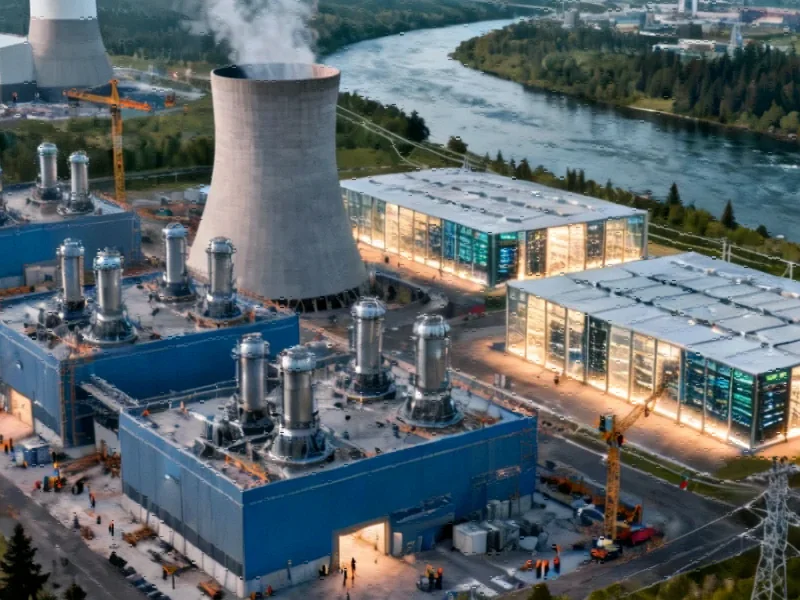The Energy Crisis Fueled by AI’s Insatiable Appetite
The artificial intelligence revolution is creating an unprecedented energy dilemma. As AI models grow more sophisticated and widespread, their power requirements are increasing at an exponential rate that threatens to overwhelm existing electrical grids. This surge in demand comes at a time when the world is simultaneously grappling with climate change concerns and the need to transition away from fossil fuels. The situation has created what industry experts are calling a perfect storm in energy infrastructure.
Tech giants find themselves at the center of this challenge, with data centers and AI training clusters consuming amounts of electricity comparable to small cities. The environmental implications are significant, particularly when this power comes from carbon-intensive sources. Recent analysis of the hidden environmental cost of AI’s power hunger reveals the scale of this emerging problem and why companies are seeking alternative solutions.
Amazon’s Nuclear Ambition: Scaling Up to Meet Demand
Amazon has dramatically revised its nuclear power strategy in the Pacific Northwest, announcing that its Cascade Advanced Energy Facility will now generate triple the electricity originally planned. This ambitious scaling reflects the company’s recognition that its energy needs, particularly for Amazon Web Services and generative AI operations, are outpacing even the most aggressive earlier projections.
The enhanced facility, developed in partnership with Energy Northwest, will utilize small modular reactor (SMR) technology to produce up to 960 megawatts of electricity—enough to power hundreds of thousands of homes while meeting the substantial requirements of Amazon’s computing infrastructure. This represents a significant shift in how major technology companies approach their energy security and sustainability goals.
Technical Innovation: The SMR Advantage
Small modular reactors represent the next evolution in nuclear technology, offering several advantages over traditional nuclear plants. Their compact design allows for factory fabrication and easier transportation to site locations, significantly reducing construction timelines and costs. The Cascade facility will occupy a footprint equivalent to just a few city blocks—a fraction of the space required by conventional nuclear plants producing similar output.
The project will deploy twelve next-generation 80-megawatt high-temperature gas-cooled reactors across three construction phases. This modular approach not only speeds deployment but enhances safety through passive safety systems and reduced radioactive inventory. As highlighted in Amazon’s nuclear expansion plans, this technology represents a paradigm shift in how we think about nuclear energy deployment.
Economic and Environmental Impact
Beyond meeting Amazon’s internal energy needs, the Cascade project promises substantial regional benefits. The construction phase is expected to create more than 1,000 temporary jobs, with over 100 permanent positions once the facility becomes operational in the 2030s. This investment comes at a time when financial institutions are increasingly scrutinizing the environmental credentials of major corporate projects.
From an environmental perspective, the nuclear facility will provide consistent, carbon-free power regardless of weather conditions—addressing one of the key limitations of renewable sources like solar and wind. This reliability is crucial for data centers that require uninterrupted power 24/7. The project represents a significant step toward decarbonizing the technology sector’s energy consumption while supporting grid stability.
Addressing Concerns and Building Partnerships
Amazon has faced scrutiny from environmental groups, academic institutions, and Native American tribes concerned about safety and ecological impacts. The company has emphasized the advanced safety features of SMR technology and its commitment to transparent operations. Unlike traditional reactors that require large exclusion zones, SMRs incorporate enhanced safety systems that automatically shut down and cool without operator intervention or external power.
The technology partnership strategy extends beyond Energy Northwest. Amazon’s investment in X-Energy and collaboration with South Korean power utilities Doosan Enerbility and Korea Hydro & Nuclear Power Company demonstrates a comprehensive approach to advancing SMR deployment. These industry partnerships reflect broader trends in technology and energy convergence as companies seek sustainable power solutions.
The Broader Implications for Tech and Energy Sectors
Amazon’s nuclear initiative signals a fundamental shift in how technology companies approach energy infrastructure. Rather than simply purchasing power from utilities, they’re increasingly investing directly in generation capacity—particularly carbon-free sources that can provide the reliable, massive-scale power required by advanced computing applications.
This trend is accelerating across the industry, with major players exploring similar strategies to secure their energy futures. The move toward self-sufficient power generation represents both a practical response to growing energy demands and a strategic positioning for future market opportunities in embedded services and technology platforms.
Looking Ahead: The Future of Tech-Powered Energy
As the Cascade project moves toward its construction start later this decade, it will serve as a critical test case for the integration of advanced nuclear technology with technology company operations. Success could pave the way for similar projects nationwide, potentially reshaping both the technology and energy landscapes.
The project’s timing aligns with broader industry developments that see technology companies taking increasingly active roles in energy innovation. With AI’s power requirements continuing to grow, the solutions pioneered by Amazon today may become standard practice across the technology sector tomorrow, creating new paradigms for sustainable digital infrastructure.
The bottom line: Amazon’s expanded nuclear ambitions represent more than just a corporate energy project—they signal a fundamental rethinking of how we power the digital future while addressing climate concerns. As technology continues to evolve at breakneck speed, the energy solutions supporting it must evolve just as rapidly.
This article aggregates information from publicly available sources. All trademarks and copyrights belong to their respective owners.
Note: Featured image is for illustrative purposes only and does not represent any specific product, service, or entity mentioned in this article.



